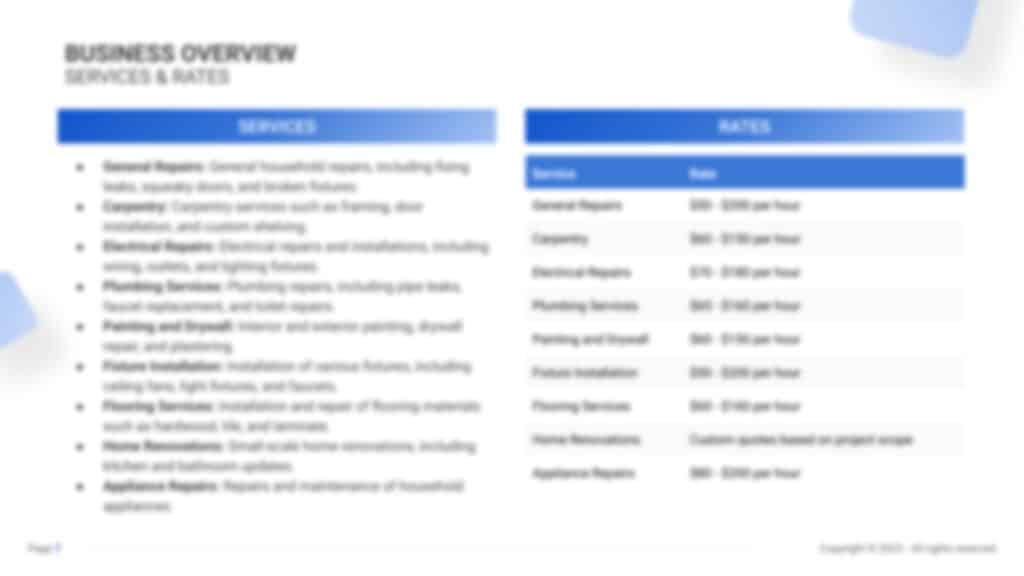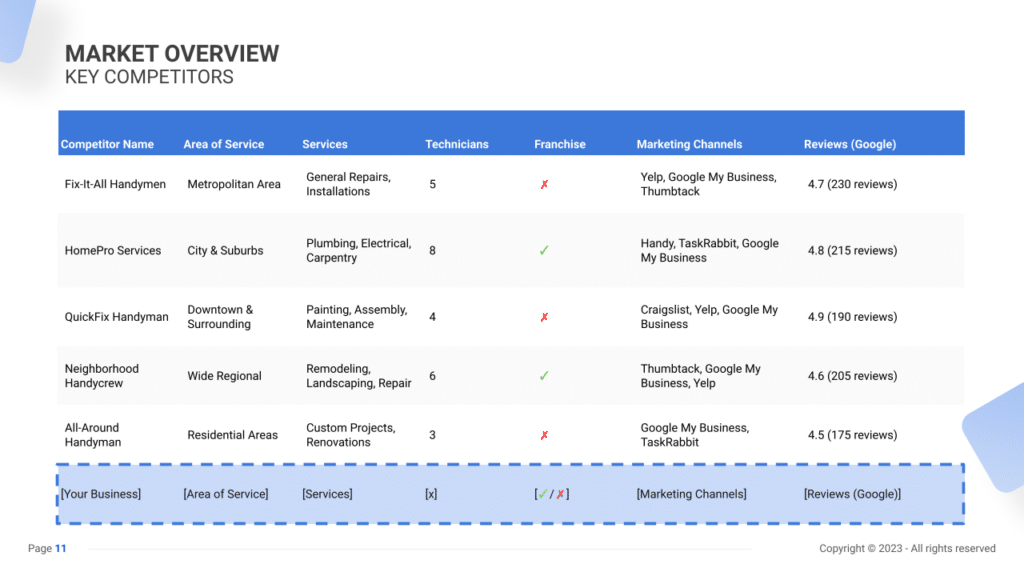Handyman Business Plan Template & PDF Example

Creating a comprehensive business plan is crucial for launching and running a successful handyman business. This plan serves as your roadmap, detailing your vision, operational strategies, and financial plan. It helps establish your handyman business’s identity, navigate the competitive market, and secure funding for growth.
This article not only breaks down the critical components of a handyman business plan, but also provides an example of a business plan to help you craft your own.
Whether you’re an experienced entrepreneur or new to the service industry, this guide, complete with a business plan example, lays the groundwork for turning your handyman business concept into reality. Let’s dive in!
The Plan
Our handyman service business plan is structured to cover all essential aspects needed for a comprehensive strategy. It outlines the service’s operations, marketing strategy, market environment, competitors, management team, and financial forecasts.
- Executive Summary: Offers an overview of your handyman business’s concept, market analysis, management, and financial strategy.
- Business Overview: Provides detailed information on what your handyman business offers and its operational model:
- Services & Location: Describes the range of handyman services offered, the flexibility of on-site service delivery, and why the service area chosen is ideal for reaching target customers.
- Service List & Pricing: Lists the handyman services provided, including minor repairs, installations, renovations, and the pricing model.
- Market Overview: Examines the home improvement and repair industry landscape, identifying competitors and how your handyman service stands out:
- Key Stats: Shares industry size, growth trends, and relevant statistics for the handyman market.
- Key Trends: Highlights recent trends affecting the home maintenance and improvement sector.
- Key Competitors: Analyzes main competitors in the service area and how your business offers unique value.
- Strategy: Outlines how the handyman business intends to achieve growth and attract clients:
- SWOT: Strengths, weaknesses, opportunities, and threats analysis specific to handyman services.
- Marketing Plan: Details strategies for attracting new customers and retaining existing ones, including digital presence, local advertising, and referral programs.
- Timeline: Sets out key milestones and objectives from the business launch through the first year of operation.
- Management: Provides information on who manages the handyman business and their roles, emphasizing experience in home repairs and customer service.
- Financial Plan: Projects the business’s 5-year financial outlook, detailing expected income from services, cost management strategies, and anticipated profit margins.

Executive Summary
The Executive Summary introduces your handyman business plan, providing a succinct overview of your company and its offerings. It should describe your market positioning, the array of home repair and maintenance services you provide, its location, size, and a brief on daily operations.
This section should also delve into how your handyman business will fit into the local market, including the number of direct competitors in the area, identifying who they are, along with your business’s unique selling points that set it apart from these competitors.
Moreover, information about the management and co-founding team, detailing their roles and contributions to the business’s success, should be included. Additionally, a summary of your financial projections, including revenue and profits over the next five years, should be presented here to provide a clear picture of your handyman business’s financial plan.
Handyman Business Plan Executive Summary Example


Business Overview
The business overview serves as the cornerstone introduction to your handyman service within the executive summary. Crucial details such as the service name, operational location, and an overview of the diverse services offered should be succinctly communicated.
This section sets the stage for highlighting the unique selling proposition (USP) of your service. Whether your focus is on versatile expertise, reliability, competitive pricing, or commitment to customer satisfaction, the USP should be the focal point that distinguishes your service.
Example:
“HandyPro Services,” centrally located in [City Name], provides prompt and proficient handyman solutions within a [x]-mile radius. Our extensive service range covers general repairs, carpentry, plumbing, electrical work, painting, appliance installation, and routine maintenance. Renowned for our versatility and reliability, we specialize in addressing diverse repair and improvement tasks, enhancing property functionality and value.
Market Overview
An insightful presentation of the broader home improvement industry, encompassing handyman services, is crucial. This section aims to underscore the significant market size, growth trends, and industry dynamics, substantiated by pertinent data on market valuation, growth rates, and emerging trends.
Additionally, a comprehensive analysis of the competitive landscape is essential. Identifying key competitors and elucidating your service’s positioning within this landscape is an opportunity to showcase its unique approach. Whether through comprehensive service offerings, transparent pricing structures, or a reputation for exceptional customer satisfaction, this is where your service’s competitive edge is emphasized.
Example:
The broader home improvement industry, which includes handyman services, stands as a formidable market valued at approximately $577 billion, projecting a steady +3.70% CAGR from 2021 to 2025. Within the handyman sector, HandyPro Services operates within a [x]-mile radius, amidst a landscape primarily comprised of independent contractors and small businesses. Our emphasis on versatile expertise and customer satisfaction positions us uniquely among competitors, resonating with clients seeking reliable and proficient handyman solutions.
Management Team
The proficiency and expertise of the management team play a pivotal role in the success of a handyman service. Within the executive summary, it’s crucial to showcase the qualifications and experiences of key team members, underscoring their vital roles in steering the service towards excellence.
This section aims to highlight the core competencies and professional backgrounds of the team, assuring potential investors and partners of the service’s adeptness and capability to thrive in the industry.
Example:
At HandyPro Services, our leadership boasts a wealth of expertise across various home repair and improvement tasks. Their leadership ensures stringent quality control, and effective project management, and fosters enduring client relationships, fundamental to our service’s success.
Financial Plan
The financial plan section encapsulates the strategic fiscal objectives and projections of your handyman service. It offers a concise overview of revenue targets, and profit margins, and outlines the trajectory guiding the service’s financial growth.
Example:
HandyPro Services is dedicated to achieving substantial milestones in its financial growth trajectory, aiming for a notable annual revenue of $1.1 million, complemented by a commendable [21]% profit margin (EBITDA) by 2028. Our financial strategy hinges on maintaining competitive pricing structures while achieving commendable profitability, emphasizing a relentless pursuit of superior service quality and client satisfaction.
Business Overview
Services & Rates
Detail the range of home repair and maintenance services provided, from basic repairs like fixing leaky faucets and changing light fixtures to more specialized services such as kitchen remodels, painting, or installing home automation systems.
Outline your pricing strategy, ensuring it reflects the value of the services provided and aligns with the market you’re targeting. Highlight any service bundles, seasonal maintenance packages, or loyalty discounts that provide added value to your clients, encouraging repeat business and building customer loyalty.

Market Overview

Industry size & growth
In the Market Overview of your handyman business plan, start by exploring the size of the home improvement and maintenance industry and its growth potential. This analysis is vital for understanding the market’s breadth and pinpointing opportunities for expansion.
Key market trends
Continue by discussing recent market trends, such as the increasing homeowner preference for professional and reliable home maintenance services, the rise of smart home installations, and the growing interest in sustainable and energy-efficient home upgrades. For example, highlight the demand for services that cater to home automation, the eco-conscious homeowner, and the surge in DIY project assistance.
Competitive Landscape
A competitive analysis is not just a tool for gauging the position of your handyman business in the market and its key competitors; it’s also a fundamental component of your business plan. This analysis helps in identifying your handyman business’s unique selling points, essential for differentiating your business in a competitive market.
In addition, competitive analysis is integral in laying a solid foundation for your business plan. By examining various operational aspects of your competitors, you gain valuable information that ensures your business plan is robust, informed, and tailored to succeed in the current market environment.
Identifying Your Competitors in the Handyman Industry
The initial step in conducting a competitive analysis for your handyman business involves identifying your direct and indirect competitors. Direct competitors might include other local handyman services specializing in similar areas such as plumbing, electrical work, carpentry, or home repairs. Additionally, consider indirect competitors, such as larger home improvement stores offering similar services or even online platforms connecting customers with freelance handymen.
Utilize online resources like business directories, Google Maps, and local listings to create a comprehensive list of competitors in your area. Websites like Yelp, HomeAdvisor, or Angie’s List can offer valuable insights into customer reviews and ratings of competitor services.

Handyman Business Competitors’ Strategies
Analyzing the strategies of your competitors encompasses various aspects that can provide essential insights into the market landscape:
- Service Offerings: Assess the range of services offered by your competitors. For instance, if a local handyman service named “FixIt All” is known for its comprehensive home repair solutions, it indicates a market need for diverse services.
- Specializations and Expertise: Consider whether competitors specialize in specific areas such as HVAC, remodeling, or emergency repairs. This specialization might cater to a particular customer segment seeking niche expertise.
- Pricing and Packages: Compare the pricing models and service packages offered by competitors. Understanding if your pricing aligns with budget-friendly services like “QuickFix Solutions” or premium services like “MasterCraft Handyman” helps position your business accordingly.
- Marketing and Promotion: Evaluate how competitors market their services. Are they utilizing digital marketing, local advertising, or relying on referrals? Understanding their promotional strategies can help in formulating your marketing approach.
- Customer Service and Satisfaction: Analyze customer feedback and reviews to identify strengths and weaknesses in your competitors’ customer service. A competitor known for prompt responses and exceptional customer support can highlight areas for improvement in your services.
- Operational Efficiency: Assess if competitors utilize technology or modern tools to enhance their efficiency. A handyman service using innovative scheduling software or providing online booking might appeal to a tech-savvy customer base.
What’s Your Handyman Business’s Value Proposition?
Reflect on what sets your handyman business apart from the competition. It could be your specialization in a particular niche, such as eco-friendly repairs or same-day emergency services, that distinguishes you.
Consider market gaps by analyzing customer needs and trends. For example, a growing demand for sustainable building practices might signal an opportunity to emphasize eco-friendly repair solutions where competitors are not focusing.
Tailor your services to your target market and location. A handyman business in a suburban area might emphasize larger renovation projects catering to homeowners, while one in an urban setting might focus on quick, on-the-go repair services for busy professionals.
Strategy

SWOT
First, conduct a SWOT analysis for the handyman business, highlighting Strengths (such as a broad range of services and quick response times), Weaknesses (including dependency on local market conditions or potential for irregular income), Opportunities (for instance, the growing trend towards home improvement and maintenance), and Threats (such as competition from larger home improvement companies or economic factors that may affect homeowners’ spending on maintenance).

Marketing Plan
Next, develop a marketing strategy that outlines how to attract and retain clients through efficient service delivery, word-of-mouth referrals, strategic local advertising, and a strong online presence, including an engaging website and active social media channels. Consider partnerships with local businesses and real estate agents to broaden your reach.
Marketing Channels
Utilize various marketing channels to enhance brand visibility, engage potential customers, and drive inquiries for your handyman services.
Digital Marketing
- Website and SEO: Establish a professional website that showcases your services, customer testimonials, and contact information. Optimize your website for local SEO to rank higher in search results for handyman services in your area.
- Social Media: Leverage social media platforms such as Facebook, Instagram, and LinkedIn to showcase completed projects, share home maintenance tips, and engage with your audience. Visual content and client testimonials can significantly boost trust and credibility.
- Email Marketing: Implement an email marketing strategy to nurture leads and stay connected with customers. Provide valuable content, seasonal offers, and service updates through regular newsletters to keep your audience engaged.
Local Advertising
- Flyers and Local Print: Utilize traditional marketing tactics like distributing well-designed flyers and brochures in local neighborhoods, community centers, and local businesses. Networking and forming partnerships with real estate agents, local hardware stores, or property management companies can expand your reach and bring in referrals.
- Networking and Partnerships: Collaborate with real estate agents, local hardware stores, or property management companies to expand your reach and gain referrals.
Promotional Activities
- Special Offers: Launch seasonal promotions like ‘Spring Home Maintenance Discounts’ or ‘Holiday Fix-Up Packages.’ Offer discounts for first-time customers to encourage trial.
- Referral Programs: Encourage satisfied customers to refer friends and family by offering them discounts or rewards for successful referrals.

Sales Channels
Implement effective sales strategies to maximize revenue and ensure customer satisfaction.
Service Upselling
- Additional Services: Offer additional services or upgrades during project consultations or while delivering ongoing services. Highlight the value of additional services such as preventive maintenance or home improvement consultations.
- Product Sales: Recommend and sell related products such as tools, hardware, or maintenance kits to customers, demonstrating their benefits.
Online Booking and Sales
- Online Scheduling: Simplify the process for customers to access your services by providing an easy-to-use online booking system. Ensure it’s available on your website and social media platforms, offering convenience and accessibility.
- E-Commerce: Consider adding an e-commerce section on your website where customers can purchase handyman-related products, DIY kits, or home maintenance packages. This not only generates additional revenue but also keeps your brand top-of-mind for future service needs.
Membership and Loyalty Programs
- Membership Options: Introduce membership options or recurring service plans at discounted rates for regular customers. Providing a monthly or quarterly service subscription can encourage repeat business and secure a more predictable revenue stream.
- Loyalty Rewards: Develop a digital loyalty program that rewards customers with points for every service they avail of. These points can be redeemed for discounts or free services after reaching specific thresholds, incentivizing customer loyalty.
Strategy Timeline
Finally, create a detailed timeline that outlines critical milestones for the handyman business’s launch, marketing initiatives, client base development, and potential service expansion, ensuring the business progresses with clear direction and purpose.

Management
The Management section focuses on the handyman business’s management and their direct roles in daily operations and strategic direction. This part is crucial for understanding who is responsible for making key decisions and driving the handyman business towards its financial and operational goals.
For your handyman business plan, list the core team members, their specific responsibilities, and how their expertise supports the business.


Financial Plan
The Financial Plan section is a comprehensive analysis of your financial projections for revenue, expenses, and profitability. It lays out your handyman business’s approach to securing funding, managing cash flow, and achieving breakeven.
This section typically includes detailed forecasts for the first 5 years of operation, highlighting expected revenue, operating costs and capital expenditures.
For your handyman business plan, provide a snapshot of your financial statement (profit and loss, balance sheet, cash flow statement), as well as your key assumptions (e.g. number of customers and prices, expenses, etc.).
Make sure to cover here
_ Profit and Loss
_ Cash Flow Statement
_ Balance Sheet
_ Use of Funds









